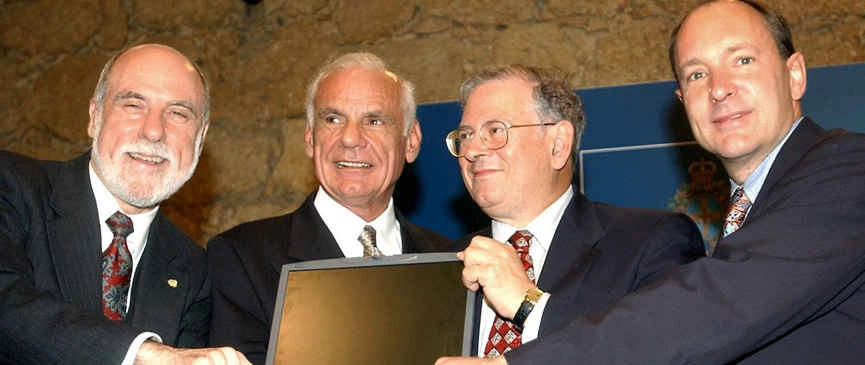Main content
Lawrence Roberts, Robert Kahn, Vinton Cerf & Tim Berners-Lee Prince of Asturias Award for Technical & Scientific Research 2002

Internet has completely revolutionised information transfer processes, and has ushered in unrestricted, worldwide information flow. The momentous research and development programme behind it has been led by a range of researchers and research teams who have applied their great vision of the future to turn what years ago was Utopia into a tangible reality by designing and setting up the protocols, the technology needed for link-up, and the access services to bring all this about. The work of Lawrence Roberts, Robert Kahn, Vinton Cerf and Tim Berners-Lee is in this sense a major step forward for the benefit of mankind.
Lawrence G. Roberts (Connecticut, USA, 1937) spearheaded the systematizing of formulas for routing and locating servers on data networks. He was also CEO of Telenet, the first packet data communications carrier, which went on to develop the X25 Protocol that became the basis of the EUNet European network. He is now the president of Caspian Networks, one of the United State's premier applied research centres.
Holder of a PhD from the Massachusetts Institute of Technology (MIT), he began working at the Defense Advanced Research Projects Agency (DARPA) in 1967, where he collaborated with Robert Kahn and Vinton Cerf in the creation of ARPANET, the first packet switching network.
Robert Kahn (New York, USA, 1938) is the joint inventor of the TCP/IP protocols, and was responsible for setting up the Defence Advanced Research Project Agency (DARPA) Internet programme. He also developed the concept of a digital object infrastructure as a middleware component for the National Information Infrastructure, providing a framework for the interoperability of heterogeneous computer systems. Since 2006, he has been chairman, CEO and president of the Corporation for National Research Initiatives, which he founded in 1986.
He is a member of the National Academy of Engineering and sits on the President of the United States’ Information Technology Advisory Committee. He received the SIGCOMM Award in 1993 and shared the 2004 Turing Award with Vint Cerf. He received the Presidential Medal of Freedom in 2005.
Vinton G. Cerf (Connecticut, USA, 1943) graduated in Mathematics at the University of Stanford, and earned a PhD in Computer Sciences at California University. Together with Robert Kahn he designed the TCP/IP computer protocols to link computers regardless of their type of connection -radio stations, satellites and telephone lines- for the military´s ARPANET. He designed MCI MAIL, the first Internet-linked e-mail service, between 1982 and 1986. Currently (2014) Vinton Cerf is the world VP and Chief Internet Evangelist of Google, an occupation he combines with that of chairman of the board of ICANN (Internet Corporation for Assigned Names and Numbers).
Recipient of the 2004 Turing Award (jointly with Robert Kahn) and the 2008 Japan Prize, he holds honorary degrees from a number of Spanish universities, namely Cartagena Polytechnic, Zaragoza, Balearic Islands, Rovira i Virgili, and the Polytechnic University of Madrid.
Tim Berners-Lee (London, Great Britain, 1955) graduated in Physics in 1976 from Queen´s College, Oxford. Whilst working as a research fellow at CERN, the European Particle Physics Laboratory, in Geneva, he conceived the idea of a global hypertext project, which years later was to become the World Wide Web. He created a prototype in 1990, and in 1991 the Web began to exert far-reaching changes on the Internet environment of the time, to the point where the world's population can now access it. Berners-Lee moved to the United States in 1994 and set up W3C, which he manages at present. This organisation is linked to the M.I.T., and works not only as a Web information storage point but also as a safeguard, defending the open Web in the face of private concerns wishing to bring in software that is subject to ownership rights.
End of main content
